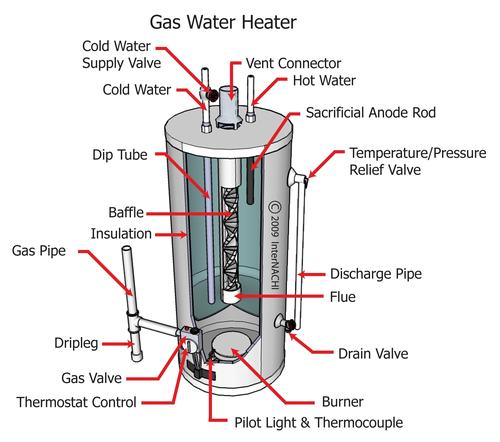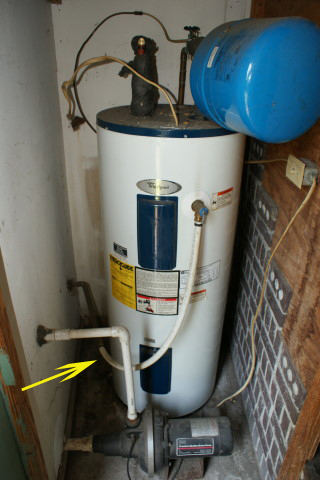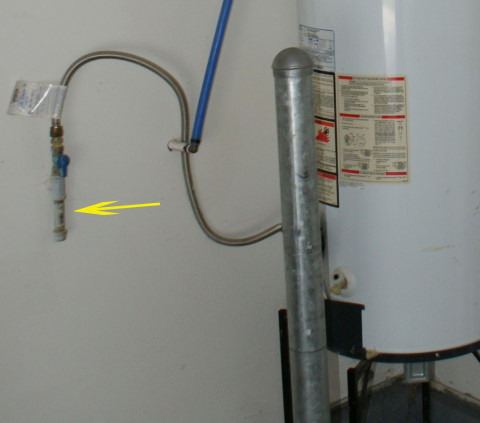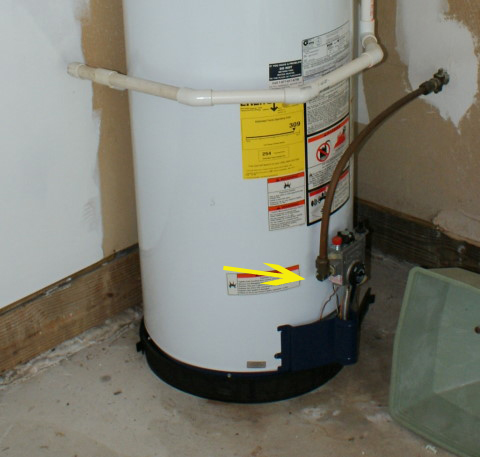- Home - Blue Palmetto Home Inspection of Summerville and Charleston
- Learn About Us and This Charleston Home Inspector
- What's Inspected
- Charleston Lowcountry Inspection Areas (geographic)
- Testimonials
- >>>Blogs (educational)
- Sample Reports & Documents
- Why Get a Home Inspection Report
- Charleston's Top Ten Reasons
- Home Inspector Photo Galleries
- Pricing
- Scheduling and Customer Information
- Home Inspection Authorization Contract
- General Scope of Work (electronic)
- Home Inspection Customer Satisfaction Survey
- Privacy Policy
- Full site
- The Roof Framers Field Manual
Charleston Home Inspector Inspects Water Heater Requirements
Submitted by Ray Thornburg on Sat, 10/27/2012 - 11:09

Charleston Home Inspector Inspects Water Heater Requirements
A water heater is one of many areas a home inspector inspects and often it is one area where we find safety hazards. Although some of the rules have changed over the years; water heater safety is of upmost concern. Did you know for instance that if the safety features of a water heater are disabled it will cause a water heater explosion which can demolish your home. So below are some of the major things we look for when inspecting water heaters.
There are some differences between the requirements and allowances for electric water heaters as compared to gas water heaters, namely in the areas of gas safety, location, and combustion and exhaust air. So lets begin our discussion of what a Charleston home inspector inspects on water heaters.
General Requirements:
· They must be sized to meet demand.
· Replacement water heaters require a permit.
· A valve is required on the cold water side at or near the WH.
· The valve must be of the full open type.
· Unions are required within 12” to allow for removal.
· A disconnect required to be in sight of the WH or use a lockable breaker when it is not within sight of a disconnect. NEC 422.31 B
· Remain accessible for service, inspection and removal.
· Must be able to fit through attic door.
· 30x30” level working platform required for working space
· Attic light and receptacle required near WH.
· Light switch required at entrance to attic.
· Fuel fired WH prohibited in storage closets, bedrooms, bathrooms, or their closets….see code for exceptions.
· Ignition source must be 18” minimum from floor of garage except a FVIR water heater. A FVIR water heater is specially designed to prevent fires and the water heater will be labeled as a FVIR (flammable vapor ignition resistant).
· Seismic bracing required (strapped).
· Barrier required in garage or carport to prevent damage from collision with autos.
· Separate or Combination TPRV (Temperature Pressure Relief Valve) is required on all WH’s.
· TPRV drain cannot be shared,must be piped separately, shall serve a single relief device and cannot connect to piping serving any other relief device or equipment, must not have valves or t fittings, must end outside or approved location (IRC allows drain pan). Note* Since the UPC does not allow the TPRV to drain to the pan and since the code says the most restrictive rules apply (when there's a conflict) then the TPRV drain should exit somewhere other than the pan. Crawlspace not allowed. reference irc 2803.6.1
· TPRV drain must end less than 6” from ground or receptor or to the water heater drain pan or to the floor (like a concrete garage floor which is sloped to provide drainage). Same size as outlet of valve.(IRC 2012 P2803.6.1#5)
· TPRV must drain by gravity – no kinks or traps - end of pipe visible- no threads
· TPRV and pan drain material can be any that’s allowed for water distribution (no PVC).
· Pan required where leakage could cause damage.
· Pan drain has to end outside or approved location.
· Bond any metal piping system capable of becoming energized (hot, cold water and gas). See our page on Grounding and Bonding for more info.
· Since copper and zinc will corrode when they touch each other; a dielectric fitting is required at the top of the water heater where the copper lines come into contact with the zinc.
· Exhaust vents shall terminate minimum 5’ above draft hood.
· Vents should be properly supported.
· Draft hood with barometric damper must be in the same space as WH.
· Fuel burning appliances need combustion air. If the appliance is in a confined space then various special procedures must be followed to provide it.
· Gas water heaters need a drip leg or sediment trap after the fuel disconnect. See this page for an explanation of what a drip leg is.
· You might see expansion tanks on newly constructed homes on the cold water line just above the water heater. Expansion tanks are used where there are antibackflow devices on the water supply. As water heats it expands back into the piping system and an expansion tank is one way to handle this.
- PEX is not allowed in the first 18" of a WH connection per manufacturer,'09 upc 604.11.2
Sources – irc 2006 chapter 20, chapter 28,irc 2903.9.2,1307.3.1-4, irc 2427, irc 2903.4.2, 2009 irc 4101.5,
Here's a picture of the various parts of a water heater courtesy of internachi. Click photos to enlarge.
Now let's take a look at some pretty pictures of water heaters taken around the Charleston area during home inspections.
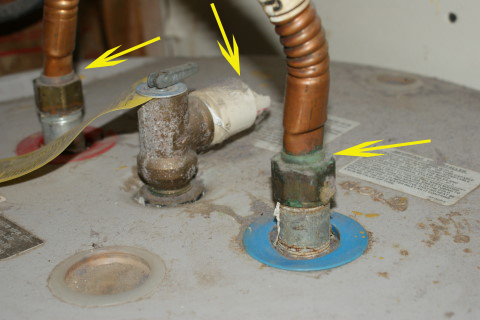 Here is an example of a dielectric union in action. See the plastic gasket designed to separate the copper from the zinc. These little gasket usually come standard in the water heater hook up kit. Also picture is the broken tprv drain line. The tprv can exhaust steam if the pressure is too great in the tank. This could cause injury if not directed safely.
Here is an example of a dielectric union in action. See the plastic gasket designed to separate the copper from the zinc. These little gasket usually come standard in the water heater hook up kit. Also picture is the broken tprv drain line. The tprv can exhaust steam if the pressure is too great in the tank. This could cause injury if not directed safely.
This water heater expansion tank was actually leaking at the rusted area during this Charleston home inspection.
Water can get trapped in this line and possibly freeze during the winter keeping the valve from functioning as intended. ( Note - Charleston always has beautiful weather... it hardly ever freezes.)
Here the drip leg should be after the shut off valve so you can service the unit. Also visible is the required barrier to damage from collision. Not visible are the required seismic straps.
Here is a water heater without a drip leg. A drip leg is needed because debris and moisture can clog the tiny orifice and cause a malfunction of the water heater. A drip leg allows a place to clean out the line. Also note that this water heater is not elevated. There may be flammable vapors in a garage so 18" elevation is required for safety. Also note no barrier but it may not have been required at the time home was built.
When a draft hood like this one is off center and not connected well dangerous carbon monoxide gasses can escape causing safety or health hazards.
Here is an interesting photo. The bottom arrow shows a t in a tprv drain line which is not allowed. Why is it there? Well at the top arrow the plumber installed a expansion valve instead of an expansion tank. An expansion valve will discharge a small amount of water. How to get rid of it. Well in this case he improperly tapped into the tprv drain line. (see the rules above) Because the TPR valve does not leak (unless the water heater needs service) this could create confusion as when to call for service.An expansion tank does not create water loss like a expansion valve might. This picture was taken on a relatively new home in the Summerville area. Because a tpr valve is a safety device we consider it a high priority to repair this improper connection.
This is a close up view of that kind of expansion device properly piped separately to the exterior of the home.
About Expansion Tanks
Heated water expands a great deal (the greater the heat the greater the expansion) so there must be some way to accommodate this extra volume. While the public utility plumbing is large enough to accommodate this extra volume; this method (of leaving the expansion tank off) is no longer allowed. This is because public utilities are recognizing the need to protect water supplies so new water meters are being installed with back flow prevention devices. So since the adaptation of the 2003 code (P2903.4) a expansion device must be installed. Also any replacement of a water heater installed in an older home since then must have an expansion device. This requirement can be met with an expansion tank or an expansion valve.
- An expansion valve as seen above can be used but some lose of water can occur with an expansion valve. The drain line must exit to an approved location (outside usually),
- An expansion tank is most commonly seen as there is no loss of water on an expansion tank. Tanks have a rubber bladder on one side (like a balloon) that is filled with air to absorb any extra volume from thermal expansion. There can be issues with expansion tanks though. Some of the most common issues are:
Common Problems with Expansion Tanks
- Most common issue is rust at fittings causing leakage. Rust can be caused by dissimilar metals in contact with each other.
- Second most common issue is installing the tank "as is". Tanks come pre-charged but the amount of air pre-charge is different for each manufacturer. The pre-charge must be adjusted by adding or removing air before installation to match the water pressure of the home. If the pre-charge is less than the normal system pressure (up to 60 psi) then the tank may be too full of water (it'll sound full when tapped) which can diminish/negate effectiveness. If the tank has too much air then then it'll (sound empty) and the tank won't properly absorb the extra pressure.
- An over/improperly pressurized expansion tank can make the TPR valve leak. (common symptom)
- Lack of support strapping can put pressure on piping and fitting is a common defect.
- Ruptured bladder can happen. If the bladder is ruptured then water will come out the air valve when it is depressed. It will also sound full when tapped with a screwdriver.
- An absent or broken expansion tank can put pressure on the piping, tanks, faucets, toilet fixtures causing leaks at intermittent times in those locations.
- A failed or absent expansion tank can have a symptom of a sudden rush of water when the faucet is turned on. The pressure will stabilize and remain stable until the system is non active for a while.
A home serviced by a well would not need an expansion tank on the water heater because there is already a tank type bladder in the well pump tank. Water heaters replaced after the adaptation of the 2003 code or homes built after that should have an expansion tank or valve. If the municipality replaces its water meters for any reason you may need to add an expansion tank even if your house and water heater is old. Here are some links to install manuals for two popular brands of water heater expansion tanks for your reference:
Every once in a while we find one done right. Seismic braces, insulated pipes,pan, expansion tank, tprv drain line correct. Good work men!
Blue Palmetto Home Inspection serves the entire Summerville/Charleston lowcountry area!

